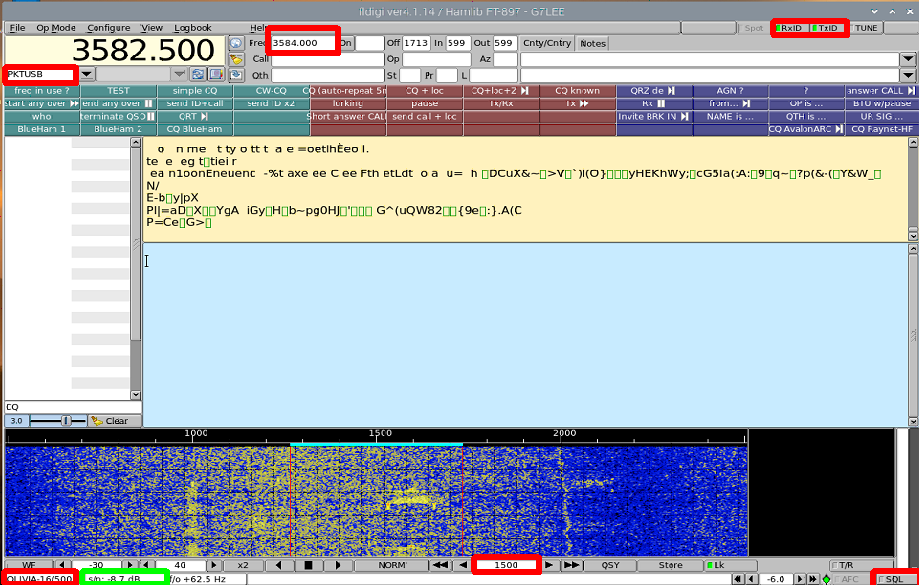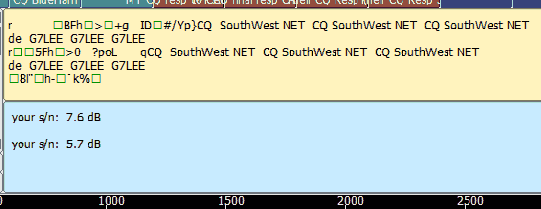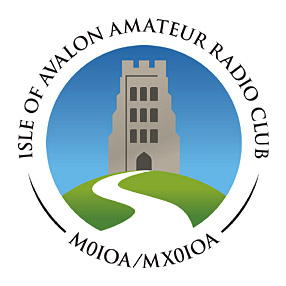SW Data Net Experiment, Tuesday 8th December 2020 21:00 GMT
This Tuesday we trialled an 80m SW wide net, using NVIS 1 The critical frequency falls at night, so 80m is not a bad choice for an evening net, however, skip will greatly increase QRM on 80m at the 9pm slot.
recommended settings - note data in USB. Proposed signal centre frequency 3.584 MHz, will go up if QRM
We will start using the Olivia 16/500 mode, which can work well with poor signal to noise ratios, so it gives us the best opportunity to cover a wider physical area. Please note the settings - I have defined these in terms of USB settings of the suppressed carrier. This is because some rigs seem to do datamodes only in USB mode. See the Olivia groups.io page, where dial frequencies on 160m and 80m are similarly 1500Hz below the signal centre frequency, indicating USB on these bands.
I am aware that common practice for frequencies below 10MHz use LSB for voice, we need to pay attention to the settings to ensure that the signal centre frequency is as expected. For clarity, here is a screenshot of FLdigi set up for 3.584 MHz, 1kHz up from the Olivia calling frequency of 3.583 centre frequency.

The centre frequency is defined as the centre of the 500Hz wide Olivia 16/500 signal. It is generated by feeding a baseband audio signal centred on 1500Hz to the rig, with the dial frequency of the rig set to the suppressed USB carrier of 3.5825 MHz. The centre of the actual radiated signal is accordingly 3.5825+.0015 = 3.584 MHz.
Please ensure you have RXID set, we will use TXID on calling CQ at the start and any mode changes, which allows you to automatically set the mode from the signal. We will not send TXID on every subsequent over, to prevent making a slow mode even slower. The values highlighted with a RED rectangle should be the same, although PKTUSB may say something slightly different depending on your CAT control settings.
Overs are quite long with Olivia 16/500 so we need to run a structured net - we will invite check-ins, please send a short transmission with just your call on the invitation, and the control station will pass the channel to the next station in turn. Please return control to net control when you have done.
Net Protocol
Olivia 16/500 is roughly 20wpm and Olivia 8/500 is about 30wpm, similar to BPSK31 but with a noticeable latency of a few seconds. This means the net will be slow. Please do NOT have TXID set, this adds a couple of seconds to your overs increasing the chance of a clash, leave RXID set as above to enable mode changes.
Please join the net sending just your call after net control invites check-ins. NC will acknowledge your call and will queue. NC will pass the net to you with
YOURCALL de NETCONTROL-CALLSIGN pse KN
and the channel is yours. For your first over please introduce yourself -
name
town/village
locator
tx power
antenna
background noise2
NC will try and capture the SNR of your signal and send it on the net later. When you are done send BTU NETCONTROL-CALLSIGN de YOURCALL and I will pass the net round to the next station. Please let us know if you are leaving the net, if you don’t respond then we’ll drop you from the list but by all means rejoin in a later check in.
The Olivia 16/500 data mode is slow. Once I have an idea of SNRs we may try to switch to 8/500 which is faster if the conditions support it.
What does the signal sound like?
This is the following text received off-air encoded in Olivia-16/500
CQ SouthWest NET CQ SouthWest NET CQ SouthWest NET
de G7LEE G7LEE G7LEE
callsign on its own
This is MX0IOA without TXID
Even just the callsign on its own without the RSID takes 9 seconds, including the preamble and postamble
You should be able to play these into FLdigi and get a decode, then the first sample will set your modem to OLIVIA-16/500
I get s/n: 7.6 dB on feeding the signal from the browser directly into FLDigi using virtual audio cable, and s/n: 5.7 dB by playing the signal out from the browser through speakers and setting FLDigi to listen through a dynamic microphone in the room. As you can see, both give a 100% decode. The garbage characters before the signal are there because squelch is off.

Farnham SDR recording at 132 km
This signal was received off-air at 10pm 5 Dec 2020 at the Farnham SDR which is located 132km east of Glastonbury.
It gives a s/n of -4 to -10dB depending on QSB. It decodes fine
CT
TEST de G7LEE G7LEE
VVV VVV VVV
TEST de G7LEE G7LEE
%
TX pwr is < 10W using a FT897 into a full-wave 80m horizontal loop ~5-7m agl
The same signal path on PSK-31 gives serviceable copy but needs twice the power and there is some data corruption.
Signal Reports
It will be interesting to see what sort of decode SNR values we get between stations, SNR is in the box highlighted in GREEN, but is ONLY valid while a signal is being received, so if you can make a note of that (and the originating station) that will be useful.
I will try and pull some of the information together, so if you could have the following information to hand:
Rig: FT 897
Ant: 80m full-wave horizontal loop
Pwr: 10W
Loc: Glastonbury IO81pd
a note of the SNR observed while receiving the signal will be valuable
eg
MX0IOA s/n 10dB de G7LEE
Creating a FLDigi macro
<CALL> your <INFO1>
allows you to insert this in the TX queue, provided you press the macro while the incoming signal is present, and have double-clicked the other station’s callsign to transfer it to the CALL box.
Note that there is quite a bit of latency - several seconds, between seeing the Olivia signal on the waterfall and getting a signal decode. Because it can decode signals that may be hardly visible, it is worth setting the squelch in FLdigi off or as low as possible. This latency makes the mode feel slower, and when checking in to the net please send a short initial call, to minimise the risk of doubling. Also please bear with me, I have never run a data net of any significant size ;)
talkback
We will listen on 145.475MHz FM and listen DMR TG810 which can be found on the Axbridge repeater GB7FI TS2 - if TS2 is free that is. You can monitor GB7FI activity here Users with Fusion/C4FM rigs eg FT991 and a Pi-Star hotspot can interwork DMR TG810 using these settings.
calling frequencies/CoA in this region
We need to be mindful of other QSOs at this time because of the wide skip catchment area. At the moment we have no data about NVIS at this frequency, we need other users from beyond groundwave reach. RSGB lists 3.58 to 3.59 as a slot for 500Hz wide modes, and 3.59 to 3.6 as another slot - there is not much room to move in these 10kHz slots.
For general awareness, I have picked this selection of calling frequencies/centre of activity in the 3.58 to 3.59 area from Olivia groups.io site and also from SV1GRB The segment 3.57 to 3.58 is allocated to 200Hz wide modes, including some of the WSJT-X modes including FT8 if you are wondering what the frenetic activity lower down is.
| Centre Frequency | mode |
|---|---|
| 3.570 | JT65 |
| 3.573 | FT8 |
| 3.575 | FT4 |
| 3.578 | JS8CALL |
| 3.580 | psk |
| 3.5814 | MFSK (Olivia etc) |
| 3.583 | Olivia (Olivia May 2020 suggested call) |
| 3.590 | RTTY |
Additional information
FLDigi datamodes software
FLDigi Olivia mode help page
RSGB 80m band plan
Olivia datamode groups.io page
-
See also Witveliet et al, Near Vertical Incidence Skywave Propagation: Elevation Angles and Optimum Antenna Height for Horizontal Dipole Antennas in Antennas and Propagation Magazine, IEEE , vol.57, no.1, pp.129-146, Feb. 2015 10.1109/MAP.2015.2397071 ↩
-
It will be interesting to see how the net performs with varying levels of background noise, this is the S meter reading with no signal, assuming no RF preamplifier engaged. ↩
